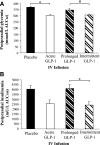Comparative effects of prolonged and intermittent stimulation of the glucagon-like peptide 1 receptor on gastric emptying and glycemia
- PMID: 24089511
- PMCID: PMC3900552
- DOI: 10.2337/db13-0893
Comparative effects of prolonged and intermittent stimulation of the glucagon-like peptide 1 receptor on gastric emptying and glycemia
Abstract
Acute administration of glucagon-like peptide 1 (GLP-1) and its agonists slows gastric emptying, which represents the major mechanism underlying their attenuation of postprandial glycemic excursions. However, this effect may diminish during prolonged use. We compared the effects of prolonged and intermittent stimulation of the GLP-1 receptor on gastric emptying and glycemia. Ten healthy men received intravenous saline (placebo) or GLP-1 (0.8 pmol/kg ⋅ min), as a continuous 24-h infusion ("prolonged"), two 4.5-h infusions separated by 20 h ("intermittent"), and a 4.5-h infusion ("acute") in a randomized, double-blind, crossover fashion. Gastric emptying of a radiolabeled mashed potato meal was measured using scintigraphy. Acute GLP-1 markedly slowed gastric emptying. The magnitude of the slowing was attenuated with prolonged but maintained with intermittent infusions. GLP-1 potently diminished postprandial glycemia during acute and intermittent regimens. These observations suggest that short-acting GLP-1 agonists may be superior to long-acting agonists when aiming specifically to reduce postprandial glycemic excursions in the treatment of type 2 diabetes.
Figures




Comment in
-
Give the receptor a brake: slowing gastric emptying by GLP-1.Diabetes. 2014 Feb;63(2):407-9. doi: 10.2337/db13-1764. Diabetes. 2014. PMID: 24464721 No abstract available.
References
-
- Inzucchi SE, Bergenstal RM, Buse JB, et al. American Diabetes Association (ADA) European Association for the Study of Diabetes (EASD) Management of hyperglycemia in type 2 diabetes: a patient-centered approach: position statement of the American Diabetes Association (ADA) and the European Association for the Study of Diabetes (EASD). Diabetes Care 2012;35:1364–1379 - PMC - PubMed
-
- Woerle HJ, Neumann C, Zschau S, et al. Impact of fasting and postprandial glycemia on overall glycemic control in type 2 diabetes Importance of postprandial glycemia to achieve target HbA1c levels. Diabetes Res Clin Pract 2007;77:280–285 - PubMed
-
- Meier JJ, Kemmeries G, Holst JJ, Nauck MA. Erythromycin antagonizes the deceleration of gastric emptying by glucagon-like peptide 1 and unmasks its insulinotropic effect in healthy subjects. Diabetes 2005;54:2212–2218 - PubMed
-
- Deane AM, Chapman MJ, Fraser RJ, et al. Effects of exogenous glucagon-like peptide-1 on gastric emptying and glucose absorption in the critically ill: relationship to glycemia. Crit Care Med 2010;38:1261–1269 - PubMed
Publication types
MeSH terms
Substances
LinkOut - more resources
Full Text Sources
Other Literature Sources
Medical

